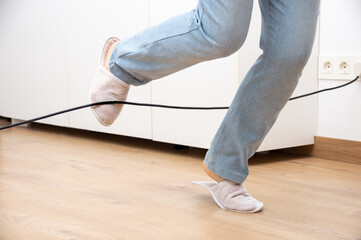Common Causes of Slip-and-Fall Accidents in New York
Slip and fall accidents are all too common and can result in serious injuries. Regardless of age or physical health, enduring a slip and fall could cause someone severe pain and a months-long recovery. For real-world examples of how devastating these incidents can be, read Why Slip-and-Fall Accidents Matter. When it’s time to protect your rights, speak to a New York slip and fall lawyer for sound advice and skilled representation.

What Are the Most Common Causes of Slip and Falls?
Slip and fall accidents can happen anywhere, from grocery store aisles to parking lots, and for many reasons. While occasional trips over one’s own feet occur, these four hazards stand out:
- Uneven flooring: Surface irregularities like cracked sidewalks, loose floorboards, bulging carpets or broken tiles catch unsuspecting shoes. These defects often develop over time through tree roots heaving concrete, water damage warping wood or heavy foot traffic wearing down tiles. Victims frequently sustain twisted ankles, fractures or tendon injuries when they catch their foot. Property owners are expected to conduct regular inspections and remedy known defects promptly; failure to do so can be evidence of negligence in court. Learn more in What Are the Top Causes of Slip and Fall Accidents?.
- Slick surfaces: Leaks from ceilings or pipes, wet mopping or spills on tile or linoleum create hidden danger zones. Even a small puddle can cause a serious fall, and under certain lighting conditions puddles are nearly invisible. Store and building managers must post visible wet floor signs and clean up spills immediately; failure to follow these protocols can support a premises liability claim. If you slipped on a wet floor, see your rights on wet floors. According to the National Floor Safety Institute, over 250,000 Americans are treated in emergency departments each year for fall-related injuries.
- Debris: Tools, boxes, extension cords and other clutter in walkways pose serious trip hazards. Construction sites, warehouses and even retail aisles can accumulate equipment or packaging materials that block safe pathways. Trips over debris often cause wrist and hip fractures as people extend their arms instinctively or they may fall backward and suffer spinal injuries. Property owners and contractors must keep aisles and public areas clear and store equipment safely; documenting cleanup schedules and employee training can be crucial evidence. Protect yourself with our 7 tips to avoid slip-and-fall accidents on your property.
- Weather: Rain turns smooth surfaces treacherous, while ice, snow or muddy spring conditions can hide hazards beneath. Black ice on sidewalks is particularly dangerous because it is virtually invisible until you are already slipping. Property owners must engage in timely snow and ice removal, apply sand or salt and warn visitors of slippery conditions. Failure to implement a reasonable winter maintenance plan can establish negligence. See how liability shifts with the elements in What Role Does Weather Play in Slip and Fall Cases?. The CDC reports that falls are the leading cause of non-fatal injuries among older adults.
How Does Premises Liability Law Factor In?
Under New York law, premises liability holds property owners and occupiers responsible for accidents that occur due to unsafe conditions. Key elements include:
- Duty of Care: Owners must inspect their property regularly and remedy or warn of known hazards within a reasonable timeframe.
- Notice: A claimant must show the owner knew, or through routine checks should have known, about the dangerous condition.
- Invitee vs. Licensee: The highest duty is owed to invitees such as customers, requiring more frequent inspections and corrective action.
- Comparative Negligence: Even if you share some fault, New York’s comparative negligence rules allow you to recover reduced damages proportional to the owner’s degree of fault.
For example, if a spill remains unattended despite employee patrols, or warning signs are not posted after a snowstorm, these failures can form the basis of a successful claim. Speak to a Nassau County slip and fall attorney to evaluate how these principles apply to your case. The U.S. Bureau of Labor Statistics notes that workplace slips and falls cost employers over $70 billion annually in workers’ compensation and lost productivity.
Why Choose Zlotolow & Associates?
Zlotolow & Associates is a personal injury firm dedicated to defending victims of negligent and reckless conduct. For more than twenty-five years, we have served New York City and Long Island, securing hundreds of financial victories for clients hurt by slip-and-fall incidents and other accidents. Our aggressive litigation approach means we refuse low-ball settlements and work tirelessly from investigation through trial to maximize your compensation.
Next Steps After a Slip-and-Fall
- Seek medical attention immediately—early diagnosis can prevent complications.
- Take detailed photos of the hazard, your injuries and the surrounding area.
- Gather witness names and contact information if available.
- Request an incident or accident report from the property owner or manager.
- Document all related expenses: medical bills, pharmacy receipts and lost wages.
- If you’re on Long Island, consider a Nassau County slip and fall attorney to guide your claim.
Your recovery and compensation matter. Contact Zlotolow & Associates, P.C. today for a free consultation—our seasoned New York personal injury lawyers are here to guide you every step of the way.

